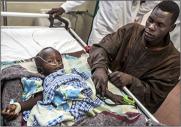当前位置:
X-MOL 学术
›
Lancet Respir. Med.
›
论文详情
Our official English website, www.x-mol.net, welcomes your feedback! (Note: you will need to create a separate account there.)
Pulse oximetry in paediatric primary care in low-income and middle-income countries.
The Lancet Respiratory Medicine ( IF 76.2 ) Pub Date : 2019-10-17 , DOI: 10.1016/s2213-2600(19)30358-3 Eric D McCollum 1 , Carina King 2 , Tim Colbourn 3 , Hamish Graham 4 , Mike Bernstein 5 , Iain H Wilson 6 , William Checkley 7
The Lancet Respiratory Medicine ( IF 76.2 ) Pub Date : 2019-10-17 , DOI: 10.1016/s2213-2600(19)30358-3 Eric D McCollum 1 , Carina King 2 , Tim Colbourn 3 , Hamish Graham 4 , Mike Bernstein 5 , Iain H Wilson 6 , William Checkley 7
Affiliation

|
Every year, pneumonia kills more children before their fifth birthday than does any other infectious disease. To end preventable deaths of neonates and children younger than 5 years by 2030 (UN Sustainable Development Goal 3.2), effective primary care interventions for child pneumonia are needed. Hypoxaemia, low blood oxygen, is a key risk factor for child pneumonia mortality. In high-income settings, pulse oximeters, non-invasive portable devices that measure the peripheral arterial oxyhaemoglobin saturation (SpO 2), have been used in routine paediatric clinical practice for more than 30 years. By contrast, most paediatric primary care settings in low-income and middle-income countries (LMICs) do not routinely use pulse oximeters at all.
中文翻译:

低收入和中等收入国家的儿科初级保健中的脉搏血氧饱和度测定法。
每年,与其他传染病相比,肺炎在五岁生日之前杀死的儿童人数更多。为了在2030年前结束新生儿和5岁以下儿童的可预防死亡(联合国可持续发展目标3.2),需要有效的儿童肺炎初级保健干预措施。低氧血症,低血氧是儿童肺炎死亡的关键危险因素。在高收入环境中,用于测量外周动脉血红蛋白血红蛋白饱和度(SpO 2)的无创便携式脉搏血氧仪已在常规儿科临床实践中使用了30多年。相比之下,低收入和中等收入国家(LMIC)的大多数儿科基层医疗机构根本没有常规使用脉搏血氧仪。
更新日期:2019-11-26
中文翻译:

低收入和中等收入国家的儿科初级保健中的脉搏血氧饱和度测定法。
每年,与其他传染病相比,肺炎在五岁生日之前杀死的儿童人数更多。为了在2030年前结束新生儿和5岁以下儿童的可预防死亡(联合国可持续发展目标3.2),需要有效的儿童肺炎初级保健干预措施。低氧血症,低血氧是儿童肺炎死亡的关键危险因素。在高收入环境中,用于测量外周动脉血红蛋白血红蛋白饱和度(SpO 2)的无创便携式脉搏血氧仪已在常规儿科临床实践中使用了30多年。相比之下,低收入和中等收入国家(LMIC)的大多数儿科基层医疗机构根本没有常规使用脉搏血氧仪。



























 京公网安备 11010802027423号
京公网安备 11010802027423号